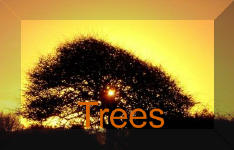Elder (Sambucus nigra)
Elder is a deciduous shrub or small tree up to 10 m tall, often branching from the base with a deeply and longly furrowed bark. It is a native of woods, scrub, roadsides and waste places, on lime- or nitrogen-rich soils.A small tree which flourishes whenever the nitrogen content of the soil is high. It is often found near abandoned dwellings and in churchyards. n woods, it often indicates existing or old rabbit warrens and badger setts where the soil has been enriched by the breakdown of dung. The stout twigs are greyish and covered with prominent 'warts' called lenticels.
Description
The 5-petalled, creamy-white flowers, 5 mm across, are in plate-like clusters up to 20 cm in diameter, which open in June and July.
Leaves
The opposite, pinnate leaves have 5-7 oval to elliptical leaflets (including a single one at the end) with toothed margins. Each is 3-9 cm long and hairy only on the veins beneath.The leaves are POISONOUS and are avoided by rabbits and cattle

Flowers
The flat white flowerhead with multiple florets are typically of hedgerows and woodland edges about late May/early June.
Fruits
The juicy, round, black fruits, which ripen in August and September, are the elderberries.
The seeds are spread in the droppings of birds which eat the berries.
Uses :
The plant colonises very quickly and can grow
very vigorously. Nowadays, some cultivars are grown in gardens for their
ornamental value. The tree has been cultivated by man for centuries and
new orchards of elder are grown to harvest the fruits and flowers to make
wines, cordials, jams and tea. The elder was a medieval medicine chest
- coughs were treated with a tea made from the flowers, the fruits and
flowers were rich in vitamin C and an extract from the bark was used as
a purgative. Dyes were obtained from different parts of the tree:- black
from the bark, green from the leaves and blue or lilac from the flowers.
The pith from inside the stem is easily cut and is still used for holding
botanical specimens while they are sectioned for microscope work. The wood
is hard and yellowish-white and was used to make small items such as toys,
combs and wooden spoons.
Generations of children used hollowed out elder stems to make whistles
and pea-shooters.

